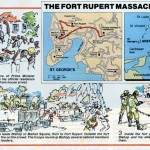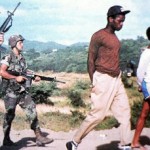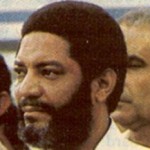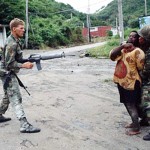US marks 30th anniversary of Grenada military intervention
The multinational operation followed the slaughter of Prime Minister Maurice Bishop along with three members of his cabinet and four others during a bloody upheaval in 1983.
WASHINGTON D.C., United States, CMC – The United States Department of Defence (DOD) says officials from US Southern Command in Miami and the US Embassy in Grenada on Friday commemorated the 30th anniversary of a “multinational intervention that rescued Grenada from chaos and restored the security and democratic institutions it enjoys today.”
US Marine General John F. Kelly, commander of US Southern Command; Larry Palmer, US Ambassador to Barbados and the Eastern Caribbean, and families of the 19 US service members killed and US veterans of the mission marked what the Grenadians have come to call “Thanksgiving Day,” according to a release from the US Armed Forces Press Service.
Hosted by Grenada Prime Minister Keith Mitchell and Governor General Cecile La Grenade, they attended Thanksgiving Day services, laid a wreath at the Intervention Memorial Monument and attended a ceremony honouring the US service members who lost their lives in the operation, the statement said.
Joining them were about 300 members of the Caribbean Peace Forces, fielded from Jamaica, Barbados and the Eastern Caribbean.
“We are grateful, first of all, for the heroism shown by Caribbean and US soldiers who, 30 years ago today, answered the call … to restore order and stability to Grenada,” Larry Palmer, US Ambassador to Barbados and the Eastern Caribbean, told the gathering at the St John’s Anglican Church where an ecumenical service was held. “In a special way too, we remember the 19 servicemen who gave the ultimate sacrifice in this noble cause.
The names of the US troops killed during the operation were read aloud by their families and members of the university’s faculty and a moment of silence was observed in tribute to their sacrifice.
The US invasion of Grenada followed the killing of Prime Minister Maurice Bishop by a firing squad on October 19, 1983, along with three members of his Cabinet and four others during a bloody upheaval.
On the morning of October 25, 1983, US forces invaded the island with a parachute assault by US Army Rangers at Point Salines and a Marine assault at Pearl.
The date of the invasion is now a national holiday in Grenada and the Point Salines International Airport was renamed in honour of Bishop
For more on this story go to:
Related story:
The forgotten invasion
Mahir Ali (Flashback) / From Khaleej Times
Ideology has a great deal to do with US military action in Grenada
Thirty years ago this week, the world’s largest military power launched an invasion of one of the tiniest Caribbean nations.
It’s not a particularly well-remembered episode, even in the context of Cold War confrontations. But it was certainly controversial at the time, condemned not just by the usual suspects, but even by some of the United States’ closest allies.
The Conservative government of Margaret Thatcher found it particularly embarrassing, given that the target, Grenada, was a member of the Commonwealth and technically its head of state was the British monarch.
Yet Washington did not bother to consult London in the run-up to the invasion, and official British documents declassified earlier this year testify to the extent of Thatcher’s consternation — exacerbated no doubt by the fact that she perceived Ronald Reagan as an ideological soulmate.
Ideology did, of course, have a great deal to do with the US military action.
Grenada had gained full independence only in 1974, after centuries of colonisation, first by the French and then by the British. It was populated largely by the descendants of African slaves, the indigenous Carib population having been wiped out during the earliest colonial phase.
Its first prime minister was Sir Eric Gairy, a longstanding politician whose title implies the British establishment’s stamp of approval. He was also an eccentric with a fascination for flying saucers, and one of his aims on the international front was to win United Nations endorsement for a Year of the Unidentified Flying Object.
More troublingly, his administration soon gained a reputation for corruption, and the growing opposition to him faced the wrath of his notorious Mongoose Squad, reputedly trained with the assistance of General Augusto Pinochet’s Chilean regime.
While visiting the UN in 1979, Gairy was overthrown in a more or less bloodless coup by the New Jewel Movement (NJM), led by a charismatic young lawyer, Maurice Bishop, whose father had been killed on independence day in 1974, conceivably by the Mongoose Squad, and who himself had subsequently suffered imprisonment and torture.
In a 2003 article on the 20th anniversary of the American invasion, University of San Francisco professor Stephen Zunes wrote that the NJM “proceeded to impose an ambitious socialist programme on the island inspired at least as much by Bob Marley as Karl Marx”. He goes on to describe the change as “an accessible revolution … carried out by English-speaking people influenced more by Black Power and New Left politics than by Soviet-style communism”.
Alienating the US was not specifically on Bishop’s agenda, but his overtures to Washington were rebuffed by the Jimmy Carter administration — including a request for assistance in constructing an airport that could accommodate large airliners, unlike the existing facility the Grenadan capital, St George’s. This was part of a pattern: the US had similarly rejected or ignored feelers from Ho Chi Minh in 1945 and Fidel Castro in 1959.
Bishop turned for assistance to Havana and Moscow, both of which were considerably more responsive. Although Grenada also maintained commercial relations with several Western powers, including Britain, the US found it convenient to cast it as part of a regional communist axis that included Cuba and Nicaragua. As for that new airport — well, in the Reagan administration’s perception, it was bound to be a Cuban-Soviet military base, notwithstanding denials not just from Bishop but from the British firm that was overseeing its construction.
In 1981, the US led a military exercise in the Caribbean that was clearly based on a planned assault against Grenada. By early 1983, Bishop was sufficiently alarmed to consider renewed overtures. He visited Washington, but Reagan refused to see him. He was fobbed off with a meeting with a State Department functionary unfamiliar even with Grenada’s geographical location.
Given its aversion to Bishop, it’s somewhat ironic that it reacted militarily only after he was overthrown by hardline colleagues, and subsequently murdered amid a popular uprising in his defence. At the time, the US portrayed its military action as a rescue mission aimed at saving about 800 American medical students on the island, even though there’s no evidence they were at any risk — and a peaceful evacuation was never even contemplated.
Reagan was keen at the time for his nation to overcome its aversion to aggression following the military debacle in Indochina — the so-called Vietnam Syndrome. Somewhat fortuitously, the invasion was unleashed just two days after 241 American marines perished in a truck-bomb attack in Beirut, thereby helping to distract attention from another debacle.
Meanwhile, the once controversial Port Salines airport eventually completed with US assistance in 1984 was 25 years later renamed Maurice Bishop International Airport.
Mahir Ali is a journalist based in Sydney
For more on this story go to:










